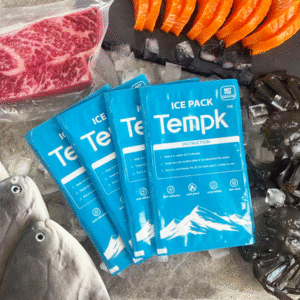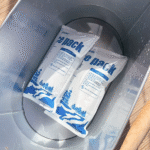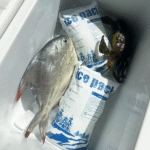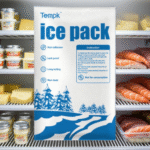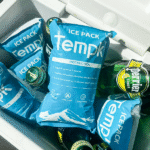Cómo empacar hielo seco para enviar carne congelada de manera segura?
El envío de carne congelada sin comprometer la calidad requiere un control preciso de la temperatura, especialmente cuando se usa hielo seco. Es fundamental comprender las cantidades adecuadas de hielo seco., los mejores materiales de embalaje, y las normas que debes seguir para garantizar que los productos cárnicos permanezcan congelados durante el tránsito y lleguen en perfectas condiciones. En esta guía, Cubriremos lo esencial de Cómo empacar hielo seco para enviar carne congelada. sin peligro, ayudándole a cumplir con 2025 pautas mientras optimiza el proceso de envío.
-
¿Cuánto hielo seco necesita cada 24 a 72 horas para un envío seguro de carne congelada??
-
¿Qué reglas de ventilación y diseño de empaque debe seguir para cumplirlas??
-
¿Cómo se coloca el aislamiento en capas?, carne, y hielo seco para mantener la temperatura?
-
¿Qué etiquetado regulatorio, documentación, y se requieren precauciones de seguridad?
-
¿Qué tendencias están surgiendo en la logística de la cadena de frío de 2025?
¿Cuánto hielo seco debe utilizar para enviar carne congelada durante 1 a 3 días??
Respuesta central:
Debe estimar entre 5 y 10 libras de hielo seco por 24 horas para condiciones típicas de envío. Sin embargo, Esta cantidad puede necesitar un ajuste dependiendo de la duración del envío., temperatura ambiente, y aislamiento utilizado.
Explicación:
El hielo seco se sublima a aproximadamente 5 a 10 libras por 24 horas, dependiendo de las condiciones de envío y de la calidad del aislamiento. Por ejemplo, al enviar 10 libras de carne, es posible que necesite alrededor 7 libras de hielo seco por día para un tránsito corto. En climas más cálidos o distancias más largas, necesitarás más. Probar su envío con registradores de temperatura ayuda a garantizar resultados óptimos.
| Duración del envío | Cantidad típica de hielo seco | Riesgo de subestimar | Aplicación práctica |
|---|---|---|---|
| 1 día (durante la noche) | 5–8 libras (2.3–3,6 kilogramos) | deshielo parcial, bordes cálidos | Envíos locales |
| 2 días | 10–15 libras (4.5–6.8 kg) | La carne se calienta o se descongela parcialmente | Envíos entre estados |
| 3 días | 15–20 libras (6.8–9 kg) | deshielo completo, pérdida de calidad | Áreas remotas o de larga distancia |
Consejo: Para tiempos de tránsito más largos o en climas cálidos, Es aconsejable aumentar la carga de hielo seco en 20% o utilice materiales aislantes más gruesos para ralentizar la sublimación.
¿Qué diseño de embalaje? & Reglas de ventilación que debes seguir?
Respuesta central:
Su embalaje siempre debe permitir la salida del gas CO₂., nunca sellar hermético, y debe incluir las etiquetas necesarias: "Hielo seco" o "dióxido de carbono, Sólido,"Y 1845, y peso neto del hielo seco en kg.
Explicación:
Mientras el hielo seco se sublima, libera co₂ gas. Si el embalaje es hermético, La presión puede acumularse y romper el recipiente.. Para evitar esto, el embalaje exterior debe tener respiraderos, y el refrigerador interior no debe estar sellado herméticamente. Los materiales de embalaje deben cumplir con las pautas de materiales peligrosos para garantizar la seguridad..
Etiquetas requeridas:
-
"Hielo seco" o "dióxido de carbono, Sólido"
-
Número de la ONU: Y 1845
-
Peso neto de hielo seco (kilos)
-
Clase 9 etiqueta de material peligroso
-
Expedidor & direcciones de destinatarios
Proceso de embalaje:
-
Caja exterior: Utilice un tablero de fibra corrugado o una caja de plástico duradera..
-
Aislamiento: Agregue paneles de espuma EPS o aislamiento rígido alrededor de la carne y hielo seco..
-
Ventilación: Asegúrese de que el paquete pueda ventilar el CO₂ al no sellar demasiado herméticamente el refrigerador interior..
Cómo colocar capas de aislamiento, Carne & Hielo seco para control de temperatura?
Respuesta central:
Al envasar carne congelada con hielo seco, El hielo seco debe rodear la carne por todos lados y colocarse encima para garantizar que el aire frío penetre a través del producto.. Se debe utilizar aislamiento para ralentizar la entrada de calor., y todos los huecos deben llenarse con materiales de embalaje.
Explicación:
-
Colocación de la carne: Coloque la carne sellada al vacío en el centro de la hielera para minimizar la exposición al aire..
-
Colocación de hielo seco: Coloque hielo seco encima y alrededor de los lados de la carne., pero evite el contacto directo con la carne para evitar quemaduras en el congelador.. Asegúrese de que el hielo seco no esté apretado y pueda sublimar sin restricciones..
-
Aislamiento: Utilice espuma u otros materiales aislantes para llenar los huecos y reducir las posibilidades de fluctuaciones de temperatura..
Ejemplo de capas de embalaje:
-
Envasar la carne al vacío y colocarla en el centro..
-
Rodee la carne con aproximadamente 10 libras de hielo seco.
-
Usar 2 pulgadas de aislamiento de espuma alrededor del hielo seco.
-
Llene los huecos con papel arrugado o aislamiento de celulosa para evitar que se mueva..
-
Asegúrese de que la tapa del refrigerador esté ligeramente abierta o tenga orificios de ventilación para permitir que escape el gas..
¿Qué etiquetado regulatorio, Documentación & Se requieren medidas de seguridad?
Respuesta central:
Cumplir con la normativa es fundamental a la hora de enviar hielo seco. Esto incluye etiquetar el paquete correctamente y garantizar que sea manipulado por personal certificado y familiarizado con los protocolos de envío de materiales peligrosos..
Explicación:
El hielo seco se considera una Clase 9 Material Peligroso, y su envío requiere una cuidadosa atención a las pautas reglamentarias para garantizar la seguridad y el cumplimiento..
Documentación clave & Seguridad:
-
Etiquetado adecuado: Siempre etiquete la caja exterior con “Hielo seco” o “Dióxido de carbono”., Sólido,” incluir el número de la ONU, y el peso neto del hielo seco.
-
Declaración del remitente: Para envíos aéreos de más de 5.5 libras (2.5 kilos), incluir una declaración del remitente para mercancías peligrosas.
-
Precauciones de manejo: Manipule siempre el hielo seco con guantes aislantes y trabaje en áreas bien ventiladas para evitar la acumulación de CO₂..
Consejos de cumplimiento:
-
Nunca selle el paquete herméticamente. Asegúrese de que el CO₂ pueda ventilarse libremente.
-
Verifique que el embalaje y el etiquetado cumplan con las reglas específicas del transportista. (p.ej., Fedex, Unión Postal Universal, USPS).
-
Utilice registradores de datos de temperatura para monitorear las condiciones internas durante el tránsito.
2025 Tendencias en el envío de hielo seco e innovaciones en la cadena de frío
Descripción general de la tendencia:
En 2025, La industria de la logística de la cadena de frío está evolucionando., con un enfoque en envases más inteligentes, Monitoreo de temperatura en tiempo real, y el uso de materiales ecológicos para mejorar la eficiencia y reducir costes.
Últimas innovaciones:
-
Monitoreo de temperatura inteligente: Los sensores conectados a IoT le avisan si la temperatura se desvía del rango deseado durante el tránsito.
-
Materiales ecológicos: Alto rendimiento, Los materiales sostenibles como los revestimientos VIP son cada vez más comunes., proporcionando un mejor aislamiento al tiempo que se reduce el impacto ambiental.
-
Optimización de rutas impulsada por IA: Las plataformas de reparto utilizan inteligencia artificial para optimizar rutas en función de las condiciones de temperatura, Minimizar los tiempos de tránsito y reducir el uso de hielo seco..
Ideas del mercado:
A medida que crece la demanda de los consumidores de envíos de carne congelada directos al consumidor, Es esencial adoptar estas innovaciones para mejorar la confiabilidad., Reducir el desperdicio, y generar confianza en el cliente. Las marcas que optimicen sus métodos de envasado de hielo seco y al mismo tiempo adopten la sostenibilidad obtendrán una ventaja competitiva.
Preguntas frecuentes (Preguntas frecuentes)
Q1: ¿Cuánto hielo seco necesito para enviar carne congelada? 48 horas?
Por lo general, necesita entre 10 y 15 libras (4.5–6.8 kg) de hielo seco para 48 horas, dependiendo de la calidad del aislamiento y la temperatura ambiente. Realice siempre una prueba con registradores de temperatura..
Q2: ¿Puedo sellar bien la caja de envío??
No, la caja debe permitir la ventilación para evitar la acumulación de presión del gas CO₂. Una caja herméticamente cerrada puede romperse durante el transporte..
Q3: ¿Qué pasa si mi envío se retrasa y se acaba el hielo seco??
Para mitigar este riesgo, incluir siempre un buffer (hielo extra seco), elegir rutas de tránsito rápido, y trabajar con transportistas que puedan reponer hielo seco si es necesario.
Resumen & Recomendaciones
Control de llave:
Cómo empacar hielo seco para enviar carne congelada de manera segura, asegúrese siempre de una ventilación adecuada, etiquetado preciso, y la cantidad adecuada de hielo seco. Utilice embalajes aislados para mantener bajas temperaturas y siga las pautas reglamentarias para garantizar el cumplimiento.. Envíos de prueba con registradores de temperatura para ajustar las cantidades de hielo seco.
Próximos pasos para usted:
-
Audite su embalaje para asegurarse de que esté optimizado para sus condiciones de envío específicas..
-
Implemente una calculadora de hielo seco para una mejor estimación de la carga.
-
Capacite a su equipo sobre el manejo de hielo seco y la comprensión de las regulaciones requeridas..
Acerca de Tempk
Nos especializamos en brindar soluciones de cadena de frío para la industria naviera., particularmente en el transporte de alimentos congelados y productos biotermales. Nuestro innovador, Opciones de embalaje ecológico., combinado con nuestra experiencia en gestión de temperatura, asegúrese de que sus productos lleguen de forma segura y a tiempo. Si necesita un plan de cadena de frío personalizado o asesoramiento sobre cumplimiento normativo, Tempk está aquí para ayudar.






